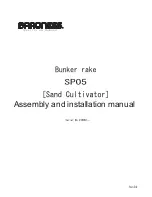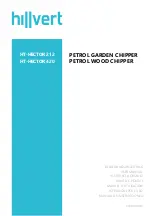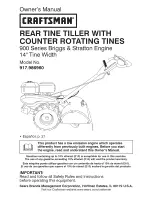
50
ARTC-SVX001B-EN
Table 10.
Recommended chiller service intervals (continued)
Task
Frequency
Confirm and record compressor amperage draw and voltage
Annually
Compare water/glycol flow against design specifications
Annually
Tighten compressor rotalock nuts
Annually
Inspect fan blades for signs of failure such as hairline fractures in the blade
Annually
Weekly
Weekly inspection is a continuation and elaboration of
daily best practice:
•
Inspect touchscreen interface panel for alarm status
and additions to the alarm history. (Do not clear
alarms as this is a very important performance
record if troubleshooting problems occur.)
•
Listen for excessive vibrations or motor noise. This
usually signals a loose brace or section of piping.
•
Measure all refrigerant static pressure on any idle
circuits. Record any significant changes or
reductions in pressure.
•
Clean strainers weekly during initial weeks after
initial start up until water quality has been reliably
established. Thereafter, inspect and clean strainers
at least monthly .
Monthly
The monthly maintenance inspection examines many
items that generally require frequent attention. This
routine event identifies small problems early before
they can become big problems requiring serious repair
and refurbishment:
1. Remove the strainer on the inlet water pipe to the
chiller and verify that it is clean and free of debris.
2. Clean the strainer’s mesh screen by back-washing
with high water velocity. If fine particles cannot be
removed with the water stream, use a mild
detergent and a non-abrasive brush to remove
them.
3. Check the compressor oil level sight glass. The oil
should always be clear and free-flowing. Any milky
or “slow rolling” effect indicates that liquid
refrigerant is making its way back into the
compressor and will cause premature compressor
failure.
N
NO
OT
TIIC
CE
E
E
Eq
qu
uiip
pm
me
en
ntt D
Da
am
ma
ag
ge
e!!
F
Fa
aiillu
urre
e tto
o rre
em
mo
ov
ve
e m
mo
oiissttu
urre
e ffrro
om
m ssy
ysstte
em
m cco
ou
ulld
d
cca
au
usse
e cco
orrrro
ossiio
on
n w
wiitth
hiin
n tth
he
e cch
hiilllle
err//h
he
ea
atte
err
cco
om
mp
po
on
ne
en
nttss,, a
an
nd
d d
de
eg
grra
ad
de
e p
pe
errffo
orrm
ma
an
ncce
e..
P
Pe
errffo
orrm
m v
va
accu
uu
um
m e
ev
va
accu
ua
attiio
on
n o
off ssy
ysstte
em
m tto
o rre
em
mo
ov
ve
e
m
mo
oiissttu
urre
e..
4. When the compressor is not operating, the oil level
should be at least at the bottom of the sight glass,
up to two-thirds full. When the compressor is
operating, the oil level will normally be at the
bottom of the sight glass, or even below, but it
must be visible.
N
NO
OT
TIIC
CE
E
C
Co
om
mp
prre
esssso
orr F
Fa
aiillu
urre
e!!
F
Fa
aiillu
urre
e tto
o ffo
ollllo
ow
w iin
nssttrru
uccttiio
on
nss b
be
ello
ow
w cco
ou
ulld
d rre
essu
ulltt iin
n
cca
atta
assttrro
op
ph
hiicc cco
om
mp
prre
esssso
orr ffa
aiillu
urre
e..
D
Do
o n
no
ott o
op
pe
erra
atte
e w
wiitth
h iin
nssu
uffffiicciie
en
ntt o
oiill..
5. Low oil sight glass conditions could signify a short
cycling, an oil leak, or an undercharged chiller that
lacks proper refrigerant velocity to return oil to the
compressor sump. Eventually, dry compressor
starts could occur causing premature compressor
failure. This may indicate that some oil has been
lost from a previous refrigerant leak repair. The
compressor data label indicates the correct oil type
and quantity with which it should be filled.
N
No
otte
e:: A flashlight may be required to see the oil
churning in the sump of the compressor.
Adjusting the line of sight may be necessary to
visually inspect the oil in the compressor sump
during operation. At a minimum, the oil must be
seen churning in the compressor sump. It should
be clear.
N
NO
OT
TIIC
CE
E
C
Co
om
mp
prre
esssso
orr F
Fa
aiillu
urre
e!!
F
Fa
aiillu
urre
e tto
o ffo
ollllo
ow
w iin
nssttrru
uccttiio
on
nss b
be
ello
ow
w cco
ou
ulld
d rre
essu
ulltt iin
n
cca
atta
assttrro
op
ph
hiicc cco
om
mp
prre
esssso
orr ffa
aiillu
urre
e..
D
Do
o n
no
ott o
op
pe
erra
atte
e w
wiitth
h iin
nssu
uffffiicciie
en
ntt o
oiill..
6. Check the glycol concentration using a
refractometer.
7. Check the refrigeration pressures. For R410A
refrigerant, low pressure refrigeration gauge should
read 120 to 160 psi and high pressure refrigeration
gauge should read 300 to 450 psi.
















































